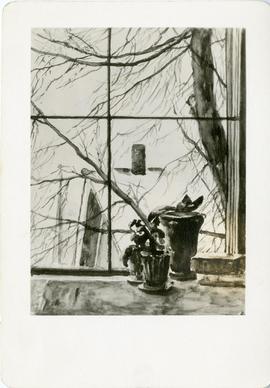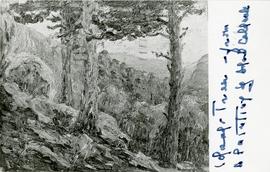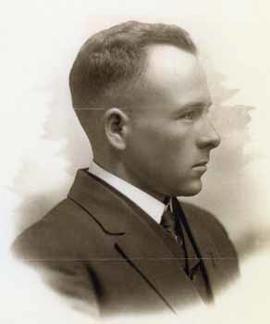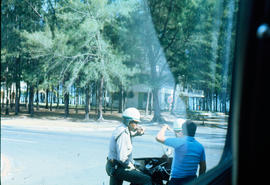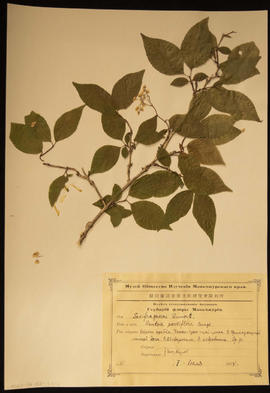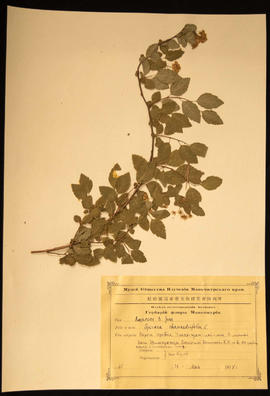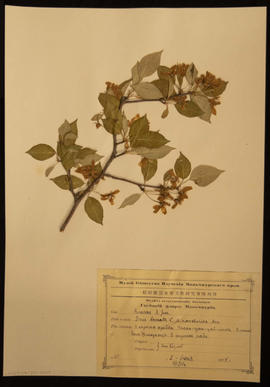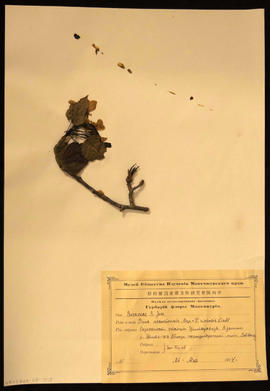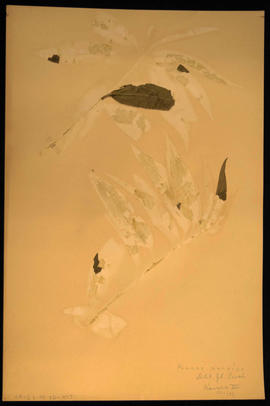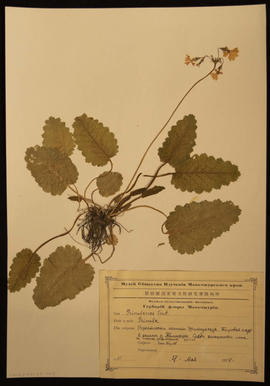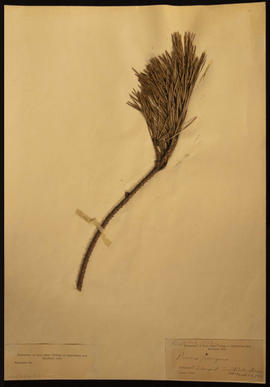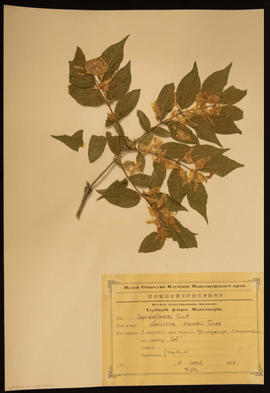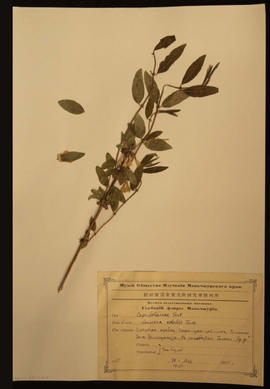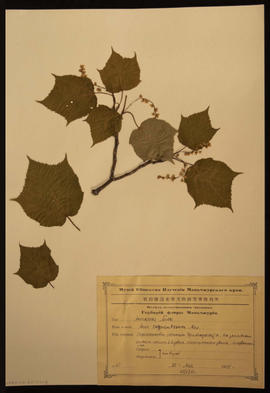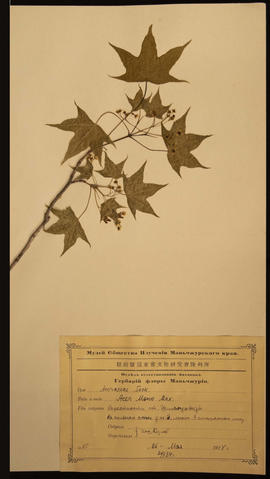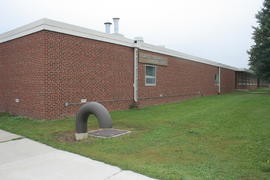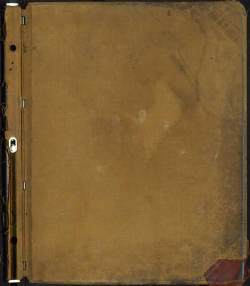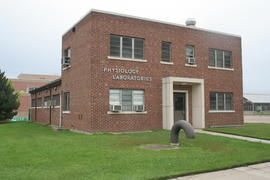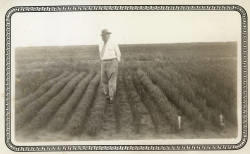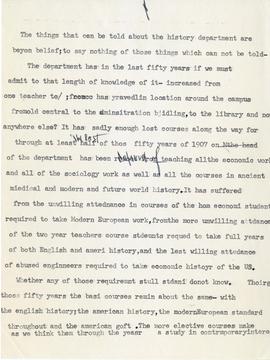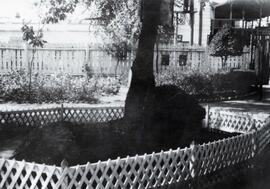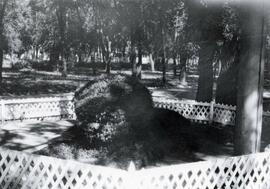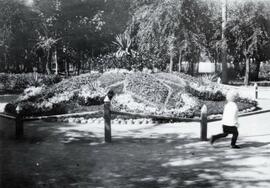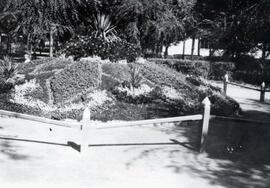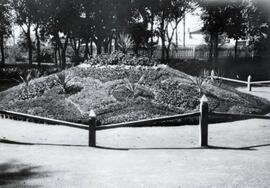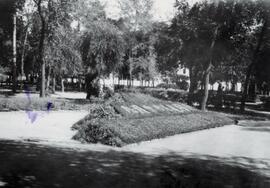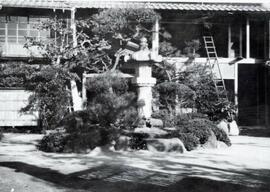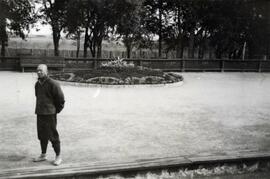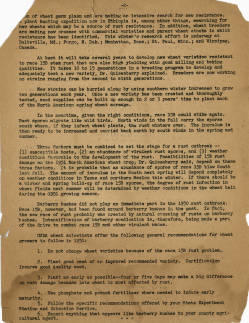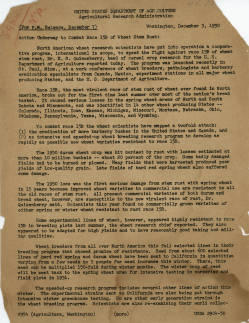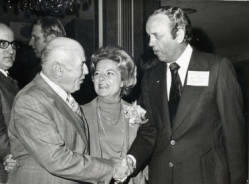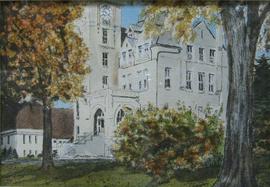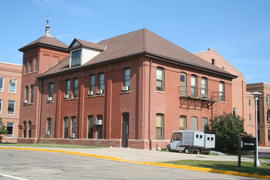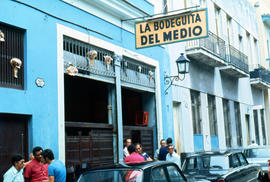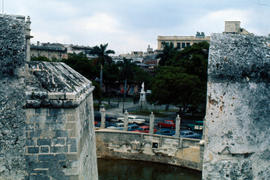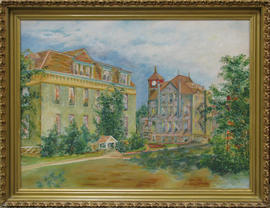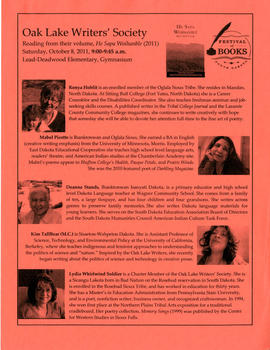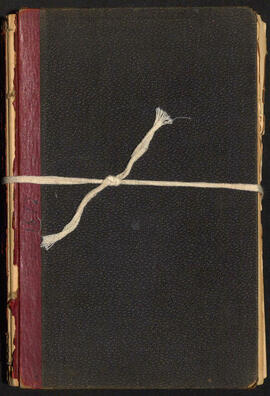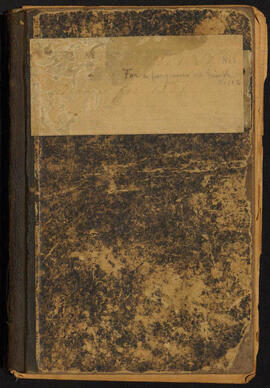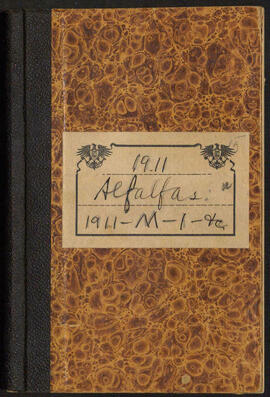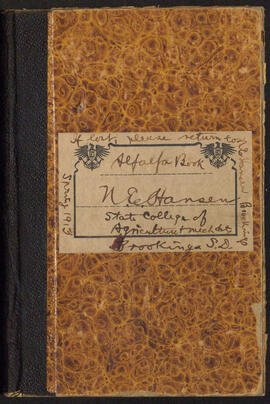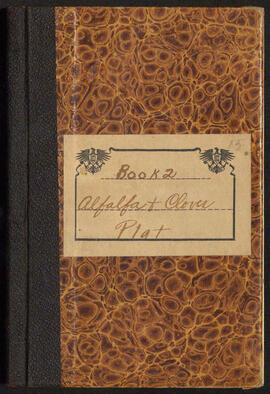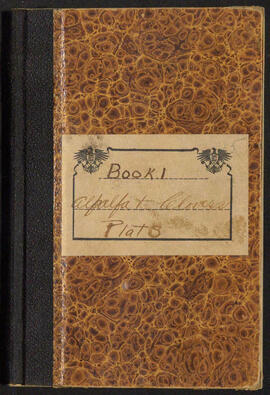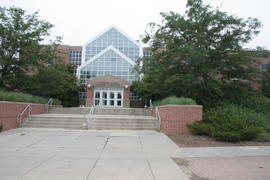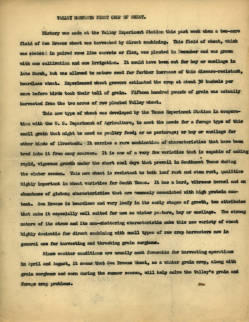Postcard of a black and white reproduction of a painting of house and trees from a painting by Ada B Caldwell, handwritten on the back
Postcard of a black and white painting by Ada B Caldwell depicting a roof and tree outside of a window with plants in the foreground. Handwritten on the back ,Greetings of the Season. Ada Caldwell. Gertrude Young. Dear L [illegible} I d so much appreciate the handsome card from you and the heartwarming memories--so good to read--though so undeserved-- Cordially GSY. A good holiday to you,
Post card to Mrs. Harry Hoyt. Depicts ,[illegible] Trees from a painting by [Ada B] Caldwell, and has handwriting on the back
Portrait of a young Edgar S. McFadden
Porters lifting iron pipes at the port on Tokyo Bay at Yokohama, Japan; written in pencil on the back: Porters lifting iron pipes at Yokohama 1924
Man speaking with police officers in Cuba
Point on the Inland Sea in Japan; written in pencil on the back Point on Inland Sea, Japan 1924
Flyer announcing a poetry reading with writers Roberta Hill, Elizabeth Cook-Lynn, Joseph Marshall III to be held at the South Dakota Art Museum in conjunction with the Oak Lake Native American Writers' Retreat.
Saxofragaceae Dumort. Ribes manshuricum (Max.) Kom. Plant specimen collected by N.E. Hansen, 1924. Saxifragaceae are found mostly in the Northern Hemisphere, with centers of diversity in the Himalayas, East Asia, and Western North America. N.E. Hansen (1866-1950) was a Danish-American horticulturist and botanist who was a pioneer in plant breeding. Hansen came to South Dakota in 1895 and became the first head of the Horticultural Department of South Dakota State College. He also served as agricultural explorer for the United States Department of Agriculture. He searched for hardy grasses, fruits, and other plants throughout Europe and Asia and brought them back to the United States to raise or crossbreed with American varieties to produce hardy plants. Specimen is mounted on an 11.5 x 16.5 inch herbarium sheet accompanied by a label printed in Russian in Cyrillic letter with hand-written notation in black ink.
Saxifragaceae Dumort. Deutzia parviflora Bunge. Plant specimen collected by N.E. Hansen, 1924. Saxifragaceae are found mostly in the Northern Hemisphere, with centers of diversity in the Himalayas, East Asia, and Western North America. N.E. Hansen (1866-1950) was a Danish-American horticulturist and botanist who was a pioneer in plant breeding. Hansen came to South Dakota in 1895 and became the first head of the Horticultural Department of South Dakota State College. He also served as agricultural explorer for the United States Department of Agriculture. He searched for hardy grasses, fruits, and other plants throughout Europe and Asia and brought them back to the United States to raise or crossbreed with American varieties to produce hardy plants. Specimen is mounted on an 11.5 x 16.5 inch herbarium sheet accompanied by a label printed in Russian in Cyrillic letter with hand-written notation in blank ink.
Rosaceae B. Juss. Spirea media Schmidt. Plant specimen collected by N.E. Hansen, 1924. N.E. Hansen (1866-1950) was a Danish-American horticulturist and botanist who was a pioneer in plant breeding. Hansen came to South Dakota in 1895 and became the first head of the Horticultural Department of South Dakota State College. He also served as agricultural explorer for the United States Department of Agriculture. He searched for hardy grasses, fruits, and other plants throughout Europe and Asia and brought them back to the United States to raise or crossbreed with American varieties to produce hardy plants. Specimen is mounted on an 11.5 x 16.5 inch herbarium sheet accompanied by a label printed in Russian in Cyrillic letter with hand-written notation in blank ink.
Rosaceae B. Juss. Spirea Chamaedrifolia L. Common name germander meadowsweet or elm-leaved spirea. Plant specimen collected by N.E. Hansen, 1924. Spiraea chamaedryfolia is a shrub reaching a height of 1–1.5 meters (3 feet 3 inches–4 feet 11 inches). Branchlets are brownish or red-brown. Leaves are simple, oblong or lance-shaped, toothed on the edges, 40–60 millimeters (1.6–2.4 inches) long and 10–30 millimeters (0.39–1.18 inches) wide, with a petiole of 4–7 millimeters. The white flowers of 6–9 millimeters in diameter grow in spike-like clusters at the ends of the branches. Flowering period extends from May to September. N.E. Hansen (1866-1950) was a Danish-American horticulturist and botanist who was a pioneer in plant breeding. Hansen came to South Dakota in 1895 and became the first head of the Horticultural Department of South Dakota State College. He also served as agricultural explorer for the United States Department of Agriculture. He searched for hardy grasses, fruits, and other plants throughout Europe and Asia and brought them back to the United States to raise or crossbreed with American varieties to produce hardy plants. Specimen is mounted on an 11.5 x 16.5 inch herbarium sheet accompanied by a label printed in Russian in Cyrillic letter with hand-written notation in black ink.
Rosaceae B. Juss. Spirea Chamaedrifolia L. Common name germander meadowsweet or elm-leaved spirea. Plant specimen collected by N.E. Hansen, 1924. Spiraea chamaedryfolia is a shrub reaching a height of 1–1.5 meters (3 feet 3 inches–4 feet 11 inches). Branchlets are brownish or red-brown. Leaves are simple, oblong or lance-shaped, toothed on the edges, 40–60 millimeters (1.6-2.4 inches) long and 10-30 millimeters (0.39-1.18 inches) wide, with a petiole of 4-7 millimeters. The white flowers of 6-9 millimeters in diameter grow in spike-like clusters at the ends of the branches. Flowering period extends from May to September. N.E. Hansen (1866-1950) was a Danish-American horticulturist and botanist who was a pioneer in plant breeding. Hansen came to South Dakota in 1895 and became the first head of the Horticultural Department of South Dakota State College. He also served as agricultural explorer for the United States Department of Agriculture. He searched for hardy grasses, fruits, and other plants throughout Europe and Asia and brought them back to the United States to raise or crossbreed with American varieties to produce hardy plants. Specimen is mounted on an 11.5 x 16.5 inch herbarium sheet accompanied by a label printed in Russian in Cyrillic letter with hand-written notation in black ink.
Rosaceae B. Juss. Pyrus ussuriensis Max +P. Sinensis Lindl. Plant specimen collected by N.E. Hansen, 1924, also known as the Ussurian pear, Harbin pear, and Manchurian pear, is a species of flowering plant in the family Rosaceae. It is native to Korea, Japan, and the Ussuri River area of far eastern Russia. N.E. Hansen (1866-1950) was a Danish-American horticulturist and botanist who was a pioneer in plant breeding. Hansen came to South Dakota in 1895 and became the first head of the Horticultural Department of South Dakota State College. He also served as agricultural explorer for the United States Department of Agriculture. He searched for hardy grasses, fruits, and other plants throughout Europe and Asia and brought them back to the United States to raise or crossbreed with American varieties to produce hardy plants. Specimen is mounted on an 11.5 x 16.5 inch herbarium sheet accompanied by a label printed in Russian in Cyrillic letter with hand-written notation in blank ink.
Rosaceae B. Juss. Prunus padus L. Plant specimen collected by N.E. Hansen, 1924, also known as bird cherry, hackberry, hagberry, or Mayday tree, is a species of cherry, native to norther Europe and northern Asia. N.E. Hansen (1866-1950) was a Danish-American horticulturist and botanist who was a pioneer in plant breeding. Hansen came to South Dakota in 1895 and became the first head of the Horticultural Department of South Dakota State College. He also served as agricultural explorer for the United States Department of Agriculture. He searched for hardy grasses, fruits, and other plants throughout Europe and Asia and brought them back to the United States to raise or crossbreed with American varieties to produce hardy plants. Specimen is mounted on an 11.5 x 16.5 inch herbarium sheet accompanied by a label with hand-written notation in pencil ink.
Rosaceae B. Juss. Micromeles alnifolia Koehne. Plant specimen collected by N.E. Hansen, 1924. N.E. Hansen (1866-1950) was a Danish-American horticulturist and botanist who was a pioneer in plant breeding. Hansen came to South Dakota in 1895 and became the first head of the Horticultural Department of South Dakota State College. He also served as agricultural explorer for the United States Department of Agriculture. He searched for hardy grasses, fruits, and other plants throughout Europe and Asia and brought them back to the United States to raise or crossbreed with American varieties to produce hardy plants. Specimen is mounted on an 11.5 x 16.5 inch herbarium sheet accompanied by a label printed in Russian in Cyrillic letter with hand-written notation in blank ink.
Prunus persica. Dbl. fl. Peach. Kaises VII. Plant specimen collected by N.E. Hansen, 1924. The peach (Prunus persica) is a deciduous tree native to the region of Northwest China between the Tarim Basin and the north slopes of the Kunlun Shan mountains, where it was first domesticated and cultivated. N.E. Hansen (1866-1950) was a Danish-American horticulturist and botanist who was a pioneer in plant breeding. Hansen came to South Dakota in 1895 and became the first head of the Horticultural Department of South Dakota State College. He also served as agricultural explorer for the United States Department of Agriculture. He searched for hardy grasses, fruits, and other plants throughout Europe and Asia and brought them back to the United States to raise or crossbreed with American varieties to produce hardy plants. Specimen is mounted on an 11.5 x 16.5 inch herbarium sheet accompanied by a label with hand-written notation in pencil ink.
Primulaceae Vent. Primula. Plant specimen collected by N.E. Hansen, 1924. N.E. Hansen (1866-1950) was a Danish-American horticulturist and botanist who was a pioneer in plant breeding. Hansen came to South Dakota in 1895 and became the first head of the Horticultural Department of South Dakota State College. He also served as agricultural explorer for the United States Department of Agriculture. He searched for hardy grasses, fruits, and other plants throughout Europe and Asia and brought them back to the United States to raise or crossbreed with American varieties to produce hardy plants.
Pinus pungens, also called Table Mountain Pine, hickory pine, prickly pine or mountain pine. This small pine is native to the Appalachian Mountains in the United States. Plant specimen collected by C.S. Sargent, 1912, first director of the Arnold Arboretum, Herbarium of Iowa College of Agriculture and Mechanic Arts, Ames, Iowa. N.E. Hansen graduated from Iowa State College with a bachelor's degree in horticulture in 1887. It is likely Hansen obtained this specimen during his time at the college. N.E. Hansen (1866-1950) was a Danish-American horticulturist and botanist who was a pioneer in plant breeding. Hansen came to South Dakota in 1895 and became the first head of the Horticultural Department of South Dakota State College. He also served as agricultural explorer for the United States Department of Agriculture. He searched for hardy grasses, fruits, and other plants throughout Europe and Asia and brought them back to the United States to raise or crossbreed with American varieties to produce hardy plants. Specimen is mounted on an 11.5 x 16.5 inch herbarium sheet accompanied by a label with hand-written notation in pencil ink.
Caprifoliaceae Vent. Lonicera Maacki Turcr. Plant specimen from the honeysuckle family collected by N.E. Hansen, 1924. This plant is native to temperate western Asia, specifically in northern and western China south to Yunnan, Mongolia, Primorsky Krai in southeastern Russia, Korea, and, albeit rare there, central and northern Honshu, Japan. N.E. Hansen (1866-1950) was a Danish-American horticulturist and botanist who was a pioneer in plant breeding. Hansen came to South Dakota in 1895 and became the first head of the Horticultural Department of South Dakota State College. He also served as agricultural explorer for the United States Department of Agriculture. He searched for hardy grasses, fruits, and other plants throughout Europe and Asia and brought them back to the United States to raise or crossbreed with American varieties to produce hardy plants.
Caprifoliaceae Vent. Lonicera edulis Turcr. Plant specimen from the honeysuckle family collected by N.E. Hansen, 1924. N.E. Hansen (1866-1950) was a Danish-American horticulturist and botanist who was a pioneer in plant breeding. Hansen came to South Dakota in 1895 and became the first head of the Horticultural Department of South Dakota State College. He also served as agricultural explorer for the United States Department of Agriculture. He searched for hardy grasses, fruits, and other plants throughout Europe and Asia and brought them back to the United States to raise or crossbreed with American varieties to produce hardy plants. Specimen is mounted on an 11.5 x 16.5 inch herbarium sheet accompanied by a label printed in Russian in Cyrillic letter with hand-written notation in black ink.
Aceraceae Neck. Acer Tomentosum Max. Plant specimen from the maple family collected by N.E. Hansen, 1924. N.E. Hansen (1866-1950) was a Danish-American horticulturist and botanist who was a pioneer in plant breeding. Hansen came to South Dakota in 1895 and became the first head of the Horticultural Department of South Dakota State College. He also served as agricultural explorer for the United States Department of Agriculture. He searched for hardy grasses, fruits, and other plants throughout Europe and Asia and brought them back to the United States to raise or crossbreed with American varieties to produce hardy plants. Specimen is mounted on an 11.5 x 16.5 inch herbarium sheet accompanied by a label printed in Russian in Cyrillic letter with hand-written notation in black ink.
Aceraceae Neck. Acer Mons Max. Plant specimen from the maple family collected by N.E. Hansen, 1924. N.E. Hansen (1866-1950) was a Danish-American horticulturist and botanist who was a pioneer in plant breeding. Hansen came to South Dakota in 1895 and became the first head of the Horticultural Department of South Dakota State College. He also served as agricultural explorer for the United States Department of Agriculture. He searched for hardy grasses, fruits, and other plants throughout Europe and Asia and brought them back to the United States to raise or crossbreed with American varieties to produce hardy plants. Specimen is mounted on an 11.5 x 16.5 inch herbarium sheet accompanied by a label printed in Russian in Cyrillic letter with hand-written notation in black ink.
Aceraceae Neck. Acer Mairunduense ? et Mey.. Plant specimen from the maple family collected by N.E. Hansen, 1924. N.E. Hansen (1866-1950) was a Danish-American horticulturist and botanist who was a pioneer in plant breeding. Hansen came to South Dakota in 1895 and became the first head of the Horticultural Department of South Dakota State College. He also served as agricultural explorer for the United States Department of Agriculture. He searched for hardy grasses, fruits, and other plants throughout Europe and Asia and brought them back to the United States to raise or crossbreed with American varieties to produce hardy plants. Specimen is mounted on an 11.5 x 16.5 inch herbarium sheet accompanied by a label printed in Russian in Cyrillic letter with hand-written notation in black ink.
Aceraceae Neck. Acer Ginnala Max. Plant specimen from the maple family collected by N.E. Hansen, 1924. N.E. Hansen (1866-1950) was a Danish-American horticulturist and botanist who was a pioneer in plant breeding. Hansen came to South Dakota in 1895 and became the first head of the Horticultural Department of South Dakota State College. He also served as agricultural explorer for the United States Department of Agriculture. He searched for hardy grasses, fruits, and other plants throughout Europe and Asia and brought them back to the United States to raise or crossbreed with American varieties to produce hardy plants. Specimen is mounted on an 11.5 x 16.5 inch herbarium sheet accompanied by a label printed in Russian in Cyrillic letter with hand-written notation in black ink.
The book contains 146 plats detailing property boundaries and ownership and leasing of lands on the Pine Ridge Reservation dating between 1936 and 2005. Changes to the plats are recorded on transparency sheets that are placed on top of the original pages. In order to provide as much detail as possible, the digitized copy of the original contains three scanned images for each plat: the transparency sheet and the original sheet, the transparency sheet alone, and the original sheet alone.
The beginning of the book includes a page describing the color code for the shading found within the pages of the book. The shading represents status of the land. Much of this page is faded and difficult to read.
The next page of the book is a typewritten copy of the "Order of Restoration, Pine Ridge Reservation," dated June 10, 1936 and attributed to Harold L. Ickes, United States Secretary of the Interior (1933-1946). The text of the document is as follows:
"Whereas, under authority contained in the Act of Congress approved May 27, 1910 (36 Stat. 440), providing for the classification and disposition of surplus unallotted lands in Bennett County, in the Pine Ridge Reservation, State of South Dakota, certain classes of said surplus lands were opened to settlement and entry under the general provisions of the homestead laws and of the said Act of Congress, by Presidential proclamation of June 29, 1911 (37 Stat. 1691), and Whereas, there are now remaining undisposed of on the opened portion of the Pine Ridge Reservation a number of tracts of said surplus lands which, while of little value for the original purpose of settlement and entry, upon thorough investigation have been found to be valuable to the Indians of the said reservation, and Whereas, by relinquishment and cancellation of homestead entries a small additional area of similar lands may be included within the class of undisposed of surplus lands, and Whereas, the Tribal Council, the Superintendent of the Pine Ridge Reservation, and the Commissioner of Indian Affairs have recommended restoration to tribal ownership of all such undisposed-of lands in the said reservation. Now, therefore, by virtue of the authority vested in the Secretary of the Interior by Sections 3 and 7 of the Act of June 18, 1934 (48 Stat. 984), I hereby find that restoration to tribal ownership of all lands which are now, or may hereafter be, classified as undisposed-of surplus opened lands of the Pine Ridge Reservation, will be in the public interest, and the said lands are hereby restored to tribal ownership for the use and benefit of the Oglala Sioux Tribe of the Pine Ridge Reservation of South Dakota, and are added to and made a part of the existing reservation, subject to any valid existing rights." The Pine Ridge Reservation plats comprise the subsequent pages. The reservation is home to the Oglala Lakota people. It is located in the southwest part of South Dakota in Oglala and Bennett Counties and portions of Jackson County. The boundaries of the Pine Ridge Reservation were established by the United States government through the act of March 2, 1889 (25 Stat. L. 888).
United States. Bureau of Indian AffairsViaggi di Pietro della Valle il Pellegrino . . . Descritti da lui medesimo in 54. Lettere familiari . . . All’erudita . . . suo amino Mario Schipano, diuissi In tre parti, cio’e la Turchia, la Persia, e l’India
Bologna: G. Longhi, 1672-1677
Italian author, poet, and composer, Pietro della Valle set off on a lengthy journey in 1614 to the East, visiting Turkey, Egypt, Palestine, Persia, and India. He recorded the story of his travels upon his return in 1929.
Edgar S. McFadden photograph of a flax nursery in Kenedy, Texas.
Back of photo of Edgar S. McFadden at a flax nursery in Kenedy, Texas. Includes handwritten notes.
Evelyn Petik, wife of Joseph Petik from rural Keldron, South Dakota, was honored in 1971 as Eminent Homemaker by South Dakota State University and the South Dakota Board of Regents.
Orville K. Peterson from Holabird, South Dakota, was honored in 1984 as Eminent Farmer by South Dakota State University and the South Dakota Board of Regents.
Group of people at an event. Some are sitting, some standing.
Three people at a campground.
Pear tree in the mountains was photographed as an example during N.E. Hansen's research on pears at Saolin in northern China; written in pencil on the back: Saolin, China my headquarters fro pears in the mountains 1924
Partial draft of a brief history of the Department of History and Political Science, South Dakota State College (SDSU), 1880s-1950s with annotations
Tree surrounded by a small lattice fence in a park in Harbin, China; written in pencil on the back: Park at Harbin 1924
Garden feature by a small lattice fence in a park in Harbin, China; written in pencil on the back: Park at Harbin 1924
Child running by the ornamental plantings surrounded by a fence in a park in Harbin, China; written in pencil on the back: Park at Harbin 1924
Ornamental plantings surrounded by a fence in a park in Harbin, China; written in pencil on the back: Park at Harbin 1924
Ornamental plantings surrounded by a fence in a park in Harbin, China; written in pencil on the back: Park at Harbin 1924
Ornamental plantings in a park in Harbin, China; written in pencil on the back: Park at Harbin 1924
Ornamental plantings and statuary in a park in Harbin, China; written in pencil on the back: Park at Harbin 1924
Man standing by some ornamental plantings in a park in Harbin, China; written in pencil on the back: Park at Harbin 1924
Agnes Panek from Spearfish, South Dakota was honored in 1988 as Eminent Homemaker by South Dakota State University and the South Dakota Board of Regents.
Orran Hofstetter (left) of Basic Incorporated in Orrville, Ohio greets Congressman Frank Denholm and his wife Millie Denholm at the National Limestone Institute Convention in Washington, D.C.
Ornate sign hanging over store in Manzhouli, Manchuria in northern China; written in pencil on the back: Manchouli North China 1924
Ornate designs on a building in Manzhouli, Manchuria in northern China; written in pencil on the back: Manchouli North China 1924
Harold N. Opdahl from Hayti, South Dakota was honored in 1949 as Eminent Farmer by the Eminent Farmer and Homemaker Club at South Dakota State College.
Lillian Olson, wife of O.V. Olson from Huron, South Dakota, was honored in 1957 as Eminent Homemaker by the Eminent Farmer and Homemaker Club at South Dakota State College.
Ernest C. Olson from Lake Norden, South Dakota was honored in 1987 as Eminent Farmer by South Dakota State University and the South Dakota Board of Regents.
Street scene in Old Havana, Cuba, with cars, men and the sign and shopfront of La Bodeguita del Medio visible
People standing on balconies in Old Havana, Cuba
View of cars and Old Havana from Fortaleza San Carlos de la Caba
Architecture in Old Havana, Cuba
Facade in Old Havana, Cuba
Ornate facade in Old Havana, Cuba
Painting by Evelyn T. Hubbard; Oil on Panel, of Old Central and Old North at South Dakota State University;
The painting is a ‘legacy’ in the archives. A handwritten note in the Greater Federation of Women’s Clubs collection from Chuck Cecil (Nov. 3, 1967) reads “Contact Mrs. Earl Washburn of Fulton, S.D. regarding painting by Mrs. Evelyn Hubbard of Old North & Old Central. They desire the painting go to the Art Center.
Mrs. W.J. O'Banion from Canton, South Dakota was honored in 1928 as Eminent Homemaker by the Eminent Farmer and Homemaker Club at South Dakota State College.
Citation and biography of Mrs. W.J. O'Banion from Canton, South Dakota who was honored in 1928 as Eminent Homemaker by the Eminent Farmer and Homemaker Club at South Dakota State College
Poster for the Oak Lake Writer's Society readings at the South Dakota Festival of Book in Lead, South Dakota. Ronya Hoblit, Mabel Picotte, Deanna Stands, Kim TallBear, and Lydia Whirlwind Soilier read from 'He Sappa Woihanble.
Brief essay on the beginnings of the Oak Lake Writers' Society held at the Oak Lake Field Station in Brookings County, South Dakota.
The bylaws and official organization of the Oak Lake Writers' Society .
Group of writers at the Oak Lake Writers' retreat that includes Charles Woodard and Elizabeth Cook-Lynn (front row).
Students and mentors discussing material around a table at the Oak Lake Writers' retreat.
Correspondence discussing the Woyake Kinikiya, a Tribel Model Literary Journal including information on who is involved and the purpose.
List of dialogue questions for the participants on the L/D/Nakota Interpretations of the River and Lewis & Clark at the Oak Lake Writers' Society retreat.
Schedule for the Twentieth anniversary conference during the Oak Lake Tribal Writers' retreat.
Announcement for writing workshops at the 20th anniversary conference during the Oak Lake Tribal Writers' retreat.
List of the mentors for the Oak Lake Retreat from 1993-2015.
Research notebook for N.E. Hansen's experiments with grasses, clovers, and forage that were conducted near the Hunter Salzer Farm by Mellet, South Dakota in 1897 with remarks about 1896. The first part of the notebook discusses his experiments on 38 plots, which included numerous varieties of grasses, oats, wheat, alfalfa, clovers, and corn. The notebook also details his research on an additional 64 plots of grasses and forage plants. The notes include his assessments of the varieties and comments regarding the weather.
Hansen, N.E. (Niels Ebbesen), 1866-1950N.E Hansen's research notebook regarding field experiments for grasses and grains in 1888 and 1889. The field consisted of 66 plots. He studied 92 varieties in total including: 22 grasses, 9 clovers, 20 wheats, 23 oats, 14 barleys, 1 rye. Hansen was assisted by John M. Aldrich, Alvah George Cross, and J.G. Ross.
Hansen, N.E. (Niels Ebbesen), 1866-1950Research notebook for N.E. Hansen's experiments with alfalfa for 1911, with notes regarding 1909 and 1910 experiments. Varieties studied include Omsk, Cossack, Samara, North Sweden, Obb Siberia, and Cherno.
Hansen, N.E. (Niels Ebbesen), 1866-1950Research notebook for N.E. Hansen's experiments with alfalfa, which were conducted throughout South Dakota in 1913. Places include Faith, Ipswich, Isabel, Kadoka, Lemmon, Miller, Mobridge, Pierre, Vivian, and Winner. Varieties studied include Samara, Cossack, Cherno, and Semipalatinsk.
Hansen, N.E. (Niels Ebbesen), 1866-1950Field research notebook of N. E. Hansen. Alfalfa and clover grasses planted May 1908. Varieties studied originated from Norway, Turkistan, Russia, Siberia, Sweden, Lapland, and South America. Several varieties came from the Moscow Agricultural College (Moscow Timiryazev Agricultural Academy).
Hansen, N.E. (Niels Ebbesen), 1866-1950Field research notebook of N.E. Hansen. Alfalfa and clover plats planted July 20, 1907. Varieties studied originated from Norway, Turkistan, Russia, Siberia, Sweden, Lapland, and South America. Handwritten
Hansen, N.E. (Niels Ebbesen), 1866-1950Roy Norman from Pierre, South Dakota was honored in 1970 as Eminent Farmer by South Dakota State University and the South Dakota Board of Regents.
Mary Elizabeth Nold, wife of George Nold from Turner County, South Dakota, was honored in 1946 as Eminent Homemaker by the Eminent Farmer and Homemaker Club at South Dakota State College.
Valley Experiment Station of the Texas Agricultural Experiment Station news release on the release of Sea Breeze, a new type of wheat. This wheat was developed by the Texas Experiment Station in cooperation with the U.S. Department of Agriculture to meet the needs for a forage typed of small grain that might be used as poultry feed; or as pasturage; or hay or ensilage for other kinds of livestock.
Ruth E. Nelson from Roberts County, South Dakota, was honored in 1984 as Eminent Homemaker by South Dakota State University and the South Dakota Board of Regents.
N.E. Hansen's headquarters while conducting pear research at Saolin in northern China; written in pencil on the back: Saolin, China my headquarters for pears in the mountains 1924
N.E. Hansen's mountain headquarters is nestled in the trees while conducting pear research at Saolin in northern China; written in pencil on the back: Saolin, China my headquarters fro pears in the mountains 1924
N.E. Hansen's mountain headquarters is nestled in the trees while conducting pear research at Saolin in northern China; written in pencil on the back: Saolin, China my headquarters fro pears in the mountains 1924
N.E. Hansen's assistants gather specimens in their search for hardy peach trees in Mendoche in northern China in 1924, one man is holding a gun; written in pencil on the back: Mendoche, North China 1924
Four of N.E. Hansen's assistants stand by a horse-drawn wagon by a building at Mendoche before they begin a search for hardy peach trees in northern China; written in pencil on the back: Mendoche 1924 North China
N.E. Hansen (wearing hat) is with friends in Brookings, South Dakota; writing on the back: S.D. plant wizard and friends Brookings 5-19-39 compliments York Sampson
N.E. Hansen is standing behind a man with a carrying pole on his shoulders and two baskets full of pears at Hansen's headquarters while conducting pear research at Saolin in northern China, there are two men accompanying them; written in pencil on the back: North China 1924

